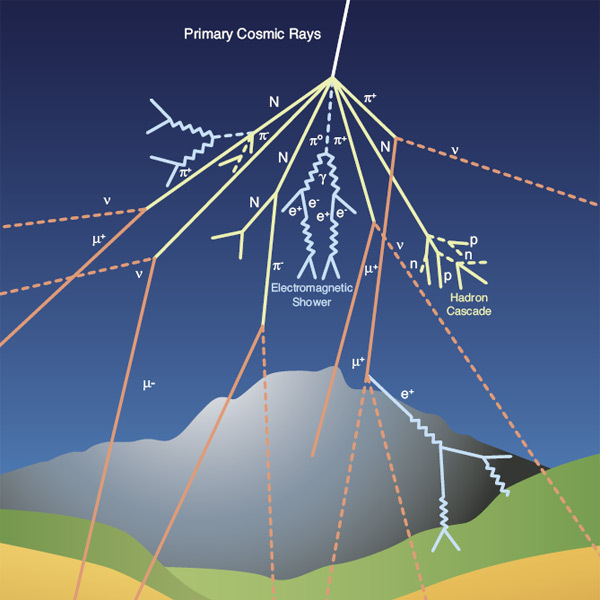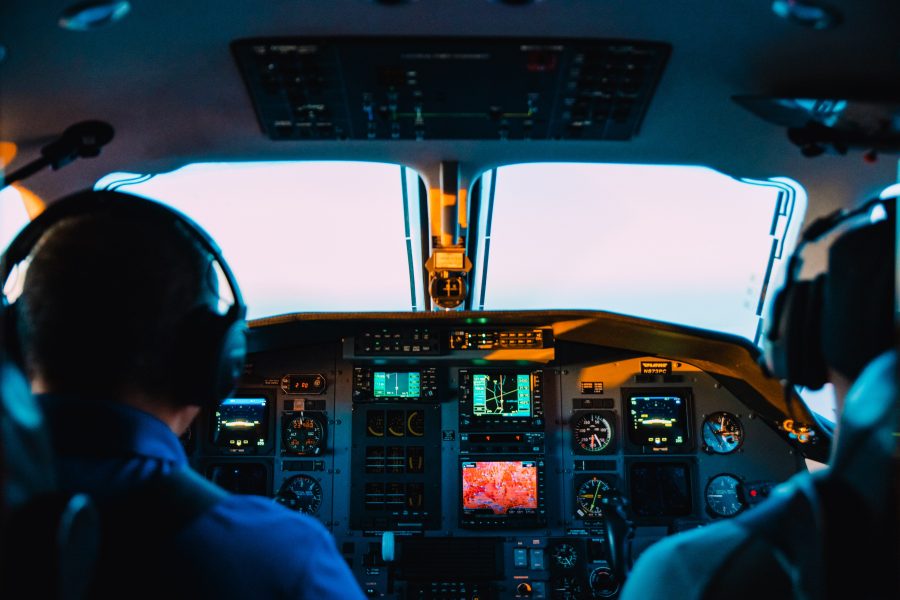What does particle physics have to do with aviation safety? Understand article
The following was adapted from an ILL News article.
Flying high: did you know that cosmic rays can interfere with aircraft systems? Learn how scientists from ILL are working with Airbus Avionics to ensure safety in the air.
Single-event effects (SEEs), which are mainly induced by neutron particles, can be responsible for soft errors in avionics equipment. SEEs thus need to be taken into account during the design of avionics systems to ensure that they don’t affect aircraft reliability and safety.

Cosmic rays and computers
Cosmic rays are high-energy particles moving through space. They are emitted by stars like our sun, but the highest energy particles come from outside the solar system, and are thought to originate from supernovae or even distant galaxies. They consist mostly of protons (89%), along with helium (10%) and heavier nuclei (1%).[1] When they collide with air particles in the Earth’s atmosphere, they produce a cascade of ionized particles and neutrons.

When these particles collide with elements in the semiconductors used in microchips or microprocessors, they can cause single-event effects (SEEs), leading to ‘bit flips’ that change the value of one position in the binary code used to encode data in computing systems. These are called ‘soft’ errors because the microchip itself isn’t damaged; the stored information is changed but can be rewritten. However, SEEs can cause malfunctions in electronic systems, which can lead to serious problems if it interferes with the functioning of a critical electronic system.

The radiation from cosmic rays increases with altitude. This can be measured with a Geiger counter when going into the mountains or taking a flight. The higher you go, the higher the Geiger readout, although this only shows the ionized particle component of cosmic rays and not the neutrons. As a result, spacecraft and even aircraft are particularly vulnerable, and a SEE could be very dangerous if it causes an error in the flight management systems on an aircraft. Fortunately, most of the time, SEEs are not a problem thanks to the redundancy of the electronics.
Semiconductors and SEEs: developing together
Neutron fluxes at cruising altitudes are about 300 times greater than at sea level, and the interactions between thermal neutrons and the boron-10 (10B) isotope found in semiconductor materials produce an alpha particle and a lithium ion capable of triggering soft errors in avionic systems. These single-event effects (SEEs) have been a concern for avionics since the late 1980s when they first began to appear in aircraft electronic systems; they had only previously been observed in orbiting satellites. As the functionality of avionic systems increases, aircraft contain more and more advanced microprocessors and semiconductor memory devices, and SEEs need to be taken into account during the design of avionics equipment in aircraft to avoid impact on reliability and safety.
During the late 1990s, thermal neutrons, or relatively slow-moving free neutrons that are not bound within an atomic nucleus, became a source of soft error because borophosphosilicate glass (BPSG) was used in the production of dielectrics found in SRAM and DRAM computer memory systems. This is because the 10B isotope tends to capture thermal neutrons from cosmic rays.[2] After the introduction of these BPSG dielectrics, the soft error rate was suddenly multiplied by eight. Integrated circuit manufacturers have more recently removed the BPSG, thus reducing thermal-neutron-induced soft error. The issue of thermal neutrons has nevertheless reappeared in modern sub-65 nm memory and logic devices due to 10B contamination in the tungsten plugs or p-type region in semiconducting elements.[3,4]
In 2019, Airbus Avionics launched a new project to characterize the risks associated with thermal neutron particles for avionics equipment. The SEE qualification for components to be used in aircraft equipment relies on the characterization of cross-sections, that is, the probability of interaction for both thermal neutrons and higher-energy neutrons (already well known). Simulations have found that the amount of thermal neutron radiation could be significantly enhanced in aeroplanes due to the thermalization of high-energy neutrons during a collision with hydrogen atoms in fuel, baggage, or passengers, but the phenomenon is very difficult to predict using models.
The only way to estimate the real thermal neutron fluxes inside an aircraft is to perform direct measurements during flights at cruising altitude. In 2021 the Institut Laue-Langevin (ILL), a research institute dedicated to neutron science and technology, became part of the Airbus Avionics project: it provided thermal neutron detectors for onboard use, while sharing its technical expertise with thermal neutrons detectors. The design, development and implementation of highly advanced neutron detectors are at the heart of the ILL’s activity, as all forty of its cutting-edge scientific instruments require detectors with unique technical specifications. The ILL neutron detector installed in an Airbus aircraft consists of 3He cylindrical proportional counters. There are 24 counters in total, mounted on 2 blocks of 12 counters each. The blocks are connected together and a charge amplifier and multi-channel analyzer are used for the readout. Pulse-height spectra are acquired for ten minutes and recorded on a computer.

© ILL
More than 30 hours of in-flight tests were planned at an altitude of 12 km – where the neutron flux is about 300 times greater than at sea level. The first flights took off in November 2021 and the campaign continued through the first half of 2022.
The data recorded provide a precise definition of the thermal neutron environment, thus helping Airbus Avionics assess the impact of thermal neutrons on its new-generation electronics and address the risks for all future Airbus Avionics projects.
A drive up the mountains as proof of concept
Since proportional counters contain thin anode wires at high voltage, they can be sensitive to vibration. It was important to prove that the system aboard an Airbus aircraft would be just as effective at detecting thermal neutron fluxes when being moved or otherwise disturbed.
The ILL is located at the foot of the French Alps, and a simple drive to the nearby ski resort of Chamrousse was sufficient to test the robustness of the mobile installation and check that it continued to record the rising intensity of the thermal neutron fluxes, as expected during the 1500 m rise in altitude.
© ILL
This collaboration is the result of years of experiments carried out by the experts at the Institut Laue Langevin, in Grenoble, France, for Airbus Avionics R&D. The ILL’s instruments were used to predict thermal neutron risk on state-of-the-art semiconductor technologies. These initial measurements allowed the Airbus Avionics Group to get in touch with ILL’s experts in neutron science and technology, thus gaining a better understanding of their skills and services in the field of thermal neutrons.
Both parties are now celebrating the success of the partnership, which demonstrates how collaboration between academic and industrial research can bring benefits to both: throughout the project, the industry develops with the help of academic expertise, while creating a new field of application for academic research and know-how.
References
[1] An article about cosmic rays on the CERN website: https://home.cern/science/physics/cosmic-rays-particles-outer-space
[2] Vázquez-Luque A et al. (2013) Neutron Induced Single Event Upset Dependence on Bias Voltage for CMOS SRAM With BPSG. IEEE Transactions on Nuclear Science 60: 4692–4696. doi: 10.1109/TNS.2013.2283532
[3] Fang YP, Oates A (2014) Thermal Neutron-Induced Soft Errors in Advanced Memory and Logic Devices IEEE Transactions on Device and Materials Reliability 14: 583–586. doi: 10.1109/TDMR.2013.2287699
[4] Gasiot G et al. (2015) Muons and thermal neutrons SEU characterization of 28nm UTBB FD-SOI and Bulk eSRAMs. IEEE International Reliability Physics Symposium 2C.2.1–2C.2.5 doi: 10.1109/IRPS.2015.7112677
Resources
- Watch a short video about cosmic rays and single-event upsets
- Learn about how cosmic rays affect electronics in this very engaging and more detailed video.
- Find out how magnetic ‘storms’ could help us achieve better, faster data storage: Chandran A (2023) Information revolution: how ultra-short bursts of light could help us improve data storage. Science in School 62.
- Use a fish tank to build a cloud chamber and detect charged particles: Barradas-Solas F, Alameda-Meléndez P (2010) Bringing particle physics to life: build your own cloud chamber. Science in School 14: 36–40.
- Read an article about life at ILL: Wildes A (2011) Life in the line of fire. Science in School 19: 10–12.





